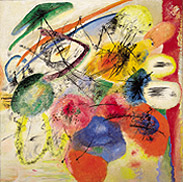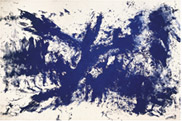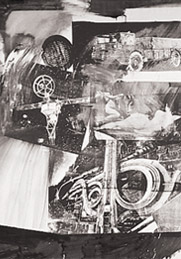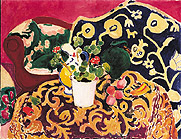

| James Rosenquist, The Swimmer in the Econo-mist (painting 1), 1997-98. Oil on canvas, 350 x 610 cm, 402 x 610 cm at center. Deutsche Guggenheim Berlin. |
| Enlarge image |
|
|
With locations in New York, Venice, Bilbao, Berlin, and Las Vegas, the Solomon R. Guggenheim Foundation has come to define the concept of the "global museum." The Global Guggenheim: Selections from the Extended Collection brings together works from this far-reaching collection for the first time in the Guggenheim's landmark, Frank Lloyd Wright building. As a broad overview of the foundation's extended holdings, the exhibition highlights the history of the avant-garde from Impressionism and early Modernism through Abstract Expressionism, Minimalism, and Pop, refracted through the vision of the individuals who have shaped the collection. In addition to works from the Guggenheim's international museums, the exhibition incorporates loans from collections with which the museum has developed original collaboration arrangements. The Gianni Mattioli Collection, Milan (on long-term loan to the Peggy Guggenheim Collection); the collection of Robert Rauschenberg; and the State Hermitage Museum, St. Petersburg all contribute to the Guggenheim's rich constellation of resources. |
|||
 Enlarge image Vasily Kandinsky, Black Lines (Schwarze Linien), December 1913. Oil on canvas, 129.4 x 131.1 cm. Solomon R. Guggenheim Museum, New York, Gift, Solomon R. Guggenheim 37.241. © 2001 Artists Rights Society (ARS), New York/ADAGP, Paris. |
This concept of the "extended
collection" is a logical progression from the
museum's early history and subsequent development.
The permanent collection of the Guggenheim Foundation
is essentially a compilation of several exceptional
and distinctive private collections that have come
together over time—the personal holdings of
Solomon R. Guggenheim, his artistic advisor Hilla
Rebay, his flamboyant niece Peggy Guggenheim, the
eminent gallery owners Justin K. Thannhauser and Karl
Nierendorf, and most recently the visionary collector
Giuseppe Panza di Biumo. Solomon's tastes, guided by Rebay, tended toward early-20th-century European abstraction by artists such as Robert Delaunay, Vasily Kandinsky, and Fernand Léger. Acquired primarily in the 1920s and 1930s on various trips to galleries and artists' studios in Europe, this collection laid the foundation for Guggenheim's first museum, established in 1939 as the Museum of Non-Objective Painting. Rebay was appointed director, and in addition to organizing shows at the museum (originally on East 54th Street, in a former automobile showroom), she immediately began implementing a series of traveling exhibitions devoted to Guggenheim's collection. From the beginning, therefore, the Guggenheim has placed great importance on reaching beyond local audiences in order to share its collection with a broader public. Such expansive ambitions soon necessitated a grander gallery space, so in 1943 Rebay launched a campaign to build a "museum-temple" designed by the visionary American architect Frank Lloyd Wright. Renamed the Solomon R. Guggenheim Museum, the elegant spiral building finally opened to the public in 1959 and has since been hailed as one of the greatest architectural achievements of the 20th century. |
||||
 Enlarge image Pablo Picasso, Woman Ironing, 1904. Oil on canvas, 116.2 x 73 cm. Solomon R. Guggenheim Museum, New York, Thannhauser Collection, Gift, Justin K. Thannhauser 78.2514.41. © 2001 Estate of Pablo Picasso/Artists Rights Society (ARS), New York. |
Pure abstraction remained the
museum's mandate until the purchase of the Karl
Nierendorf estate in 1948, which expanded the narrow
focus of the original collection to include
figurative works by Marc Chagall, Paul Klee, and
Oskar Kokoschka, among others. This major
acquisition, along with growing frustration regarding
the lack of curatorial flexibility under Rebay's
purist rubric of "non-objectivity," ushered in a new
era led by a new director, James Johnson Sweeney.
During his eight-year tenure (1952-60), Sweeney
aggressively expanded the collection, bringing in a
more eclectic and comprehensive representation of
Modern art, including sculpture, which Rebay had
rejected for its "corporeality." The acquisition of
eleven sculptures by Constantin Brancusi during
Sweeney's directorship made the Guggenheim one of the
great repositories of the artist's work. Sculptures
by Alexander Archipenko, Alexander Calder, and
Alberto Giacometti as well as notable Abstract
Expressionist paintings by Willem de Kooning and
Jackson Pollock also enriched the collection under
Sweeney's directorship. Thomas Messer succeeded Sweeney in 1961 and continued to enhance the collection by adding critical examples of Modern and contemporary art, including major works by Francis Bacon, Calder, Jean Dubuffet, Klee, Joan Miró, Robert Rauschenberg, Egon Schiele, and David Smith. Perhaps the most pivotal group of artworks to enter the museum under Messer's tenure, however, was the Thannhauser Collection, which expanded the collection's 20th-century chronology to include seminal works from the 1860s through the early 1900s. This suite of 75, early-Modern masterpieces came to the museum in 1963, when the German dealer and collector Justin K. Thannhauser offered his personal collection to the Guggenheim as a permanent loan. Priceless works by Paul Cézanne, Edgar Degas, Edouard Manet, Vincent van Gogh, Pablo Picasso, and many others have been hanging in the Wright building's Thannhauser Galleries (so renamed in 1989) ever since. They were bequeathed to the museum after Thannhauser's death in 1976, and the gift was further augmented by donations from his widow Hilde. The Thannhauser group, usually exhibited as a separate entity from the Modern and contemporary core of the collection, has been integrated into this exhibition, adding spectacular examples of Impressionist, Post-Impressionist, and School of Paris painting. |
||||
 Enlarge image Yves Klein, La Grande Anthropométrie bleue (ANT 105), ca. 1960. Pigment and synthetic resin on paper, on canvas, 280 x 428 cm. Guggenheim Museum Bilbao. © 2001 Artists Rights Society (ARS), NY/ADAGP, Paris. |
Messer's directorship also oversaw
the transfer of the Peggy Guggenheim
Collection—the works collected by Solomon's
niece Peggy and housed in the Palazzo Venier dei
Leoni in Venice—to the foundation's auspices in
1976. Painting and sculpture from Venice mark
critical moments in the evolution of 20th-century art
underrepresented in New York, namely Surrealism and
early Abstract Expressionism. Max Ernst's The
Antipope (1941-42), a grim Surrealist portrayal
of the eroding relationship between the artist and
Peggy Guggenheim, and Jackson Pollock's Enchanted
Forest (1947), an intricate and dynamic web of
spontaneously splattered paint, round out New York's
sampling of work from these periods. The Gianni
Mattioli Collection of early-20th-century Italian art
includes many Futurist masterpieces, which fill the
Guggenheim's void in this area. Umberto Boccioni's
Dynamism of a Cyclist (1913), a vigorous and
brilliantly colored study of high-speed motion,
merges the mechanics of the human body with the
shifting gears, wheels, and bars of a bicycle,
capturing the Futurist manifesto of velocity,
simultaneity, and progress. |
||||
 Full image Robert Rauschenberg, Barge, (detail), 1963. Oil and silkscreened ink on canvas, 202.9 x 980.4 cm. Solomon R. Guggenheim Museum, New York and Guggenheim Bilbao Museoa, with additional funds contributed by Thomas H. Lee and Ann Tenenbaum; the International Director's Council and Executive Committee Members. Licensed by VAGA, NY, NY. |
Thomas Krens, director since Messer's
retirement in 1988, has continued the legacy of
extending the span and depth of the collection. A
most notable attainment was the acquisition in the
early 1990s of the Panza Collection of Minimal and
Conceptual art, which has become the indispensable
basis of the Guggenheim's contemporary holdings,
represented in this exhibition with works by Carl
Andre and Robert Ryman. But Krens has also expanded
the breadth of the institution on levels beyond
traditional collecting practices by orchestrating
broad changes in the foundation's geographic
structure. The first such expansion was in New York
City in 1992 with the opening of the Guggenheim
Museum SoHo, created as a space in which to present
the burgeoning developments between contemporary art
and technology. Under Krens's direction, the Guggenheim Museum Bilbao opened to wide acclaim in 1997. Since then, the New York museum has greatly benefited from this stunning architectural arena in which to bring its collection and special exhibitions to new European audiences. In turn, monumental paintings from the Guggenheim Museum Bilbao dramatically enrich the extended collection's scope. Yves Klein's La Grande Anthropométrie bleue (ANT 105) (ca. 1960) and Robert Rauschenberg's Barge (1963), a joint purchase between the New York and Bilbao museums, exemplify Bilbao's commitment to postwar art on a grand scale. Also in 1997, Krens initiated a collaboration with Deutsche Bank, which led to the opening of the Deutsche Guggenheim Berlin. This new location added another venue for select touring exhibitions and—more uniquely—for commissions by contemporary artists such as James Rosenquist, a section of whose massive and technicolor Swimmer in the Econo-mist series is included in this exhibition. Loans to The Global Guggenheim of important canvases by André Derain, Henri Matisse, and Picasso from the Hermitage's preeminent holdings of early-Modern French painting mark the recent partnership formed between the Guggenheim and this renowned Russian collection. The Hermitage is particularly celebrated for its scores of masterpieces by Matisse, represented here by Spanish Still Life (1910)—one of over 35 works purchased from the artist by the great Russian collector Sergei Shchukin and later donated to the Hermitage. The Guggenheim-Hermitage Museum and Guggenheim Las Vegas, currently under construction, will bring both institutions' collections as well as select Guggenheim special exhibitions to a still wider audience. |
||||
 Enlarge image Henri Matisse, Spanish Still Life (Seville Still Life I), 1910. Oil on canvas, 89.5 x 116.3 cm. The State Hermitage Museum, St. Petersburg 9043. © 2001 Succession H. Matisse, Paris/Artists Rights Society (ARS), New York. |
The core of any museum is its
permanent collection. And by forging worldwide
alliances, the Guggenheim has redefined the
parameters of acquisition and ownership previously
inscribed in the concept of the museum collection.
The Global Guggenheim is not only the first
comprehensive presentation of the Guggenheim's pre-
and postwar holdings since 1992, but also it marks
the museum's leadership in innovative
collection-sharing strategies that have proven
imperative to continued collection growth at the
highest levels of aesthetic quality and historical
importance. In addition to expanding the permanent
collection, this approach has generated a
cutting-edge program of special exhibitions,
breathing new life into the contemporary concept of
the museum by putting fashion, design, multimedia,
and non-Western art into dialogue with key works in
the traditional Modernist canon. As one institution
spanning several countries, the Guggenheim is
uniquely positioned to mount a collection exhibition
that celebrates the contributions of an international
avant-garde. —Bridget Alsdorf Collections Curatorial Assistant This exhibition has been organized by Carmen Giménez. |

